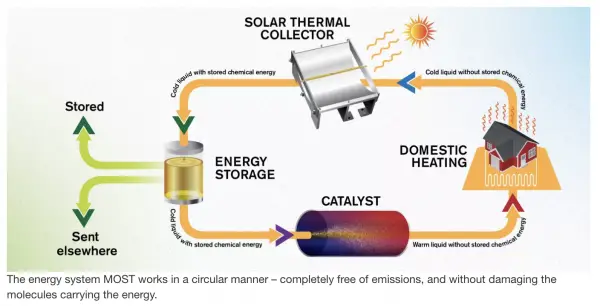Scientists Discover Liquid That Can Store The Sun’s Energy For Up To 18 Years

Researchers have been working on the development of a liquid fuel that can store the sun’s energy for up to 18 years. Findings of studies conducted on this material in the past year could pave the way for huge advances in solar technology, considering one of the biggest hurdles that the industry has faced thus far is figuring out a way to properly store and harness the energy once it is collected.
According to the abstract of the study:
The development of solar energy can potentially meet the growing requirements for a global energy system beyond fossil fuels, but necessitates new scalable technologies for solar energy storage. One approach is the development of energy storage systems based on molecular photoswitches, so-called molecular solar thermal energy storage (MOST). Here we present a novel norbornadiene derivative for this purpose, with a good solar spectral match, high robustness and an energy density of 0.4 MJ kg−1. By the use of heterogeneous catalyst cobalt phthalocyanine on a carbon support, we demonstrate a record high macroscopic heat release in a flow system using a fixed bed catalytic reactor, leading to a temperature increase of up to 63.4 °C (83.2 °C measured temperature). Successful outdoor testing shows proof of concept and illustrates that future implementation is feasible. The mechanism of the catalytic back reaction is modelled using density functional theory (DFT) calculations rationalizing the experimental observations.
The diagram below shows how the technology would work:

Jeffrey Grossman, an MIT engineer who is familiar with these materials, put the project in easier to understand terms in an interview with NBC.
“A solar thermal fuel is like a rechargeable battery, but instead of electricity, you put sunlight in and get heat out, triggered on demand…You could use that thermal energy for your water heater, your dishwasher or your clothes dryer. There could be lots of industrial applications as well,” Grossman said.
Scientists from Chalmers University of Technology in Sweden discovered this material over a year ago, and ever since, teams around the world have been working to improve upon the technology.
Kasper Moth-Poulsen, one of the scientists from Sweden, says that research on the material has exploded in popularity since he began his first studies.
“When I started, there was really only one research group working on these kinds of systems. Now there are teams in the U.S., in China, in Germany — about 15 around the world,” he says.
As Truth Theory has reported, social technology is advancing at an impressive rate.
2016 data from Bloomberg New Energy Finance (BNEF) suggests that solar has actually already become the cheapest way to generate energy.
According to a recent estimate released by the International Energy Agency, solar will be the world’s primary source of energy by 2050. Recent breakthroughs in solar technology are making it more efficient and cheaper to extract energy from the sun, which in turn, is making this technology more available to the average person.
Image credit: 123RF
Leave Comment: